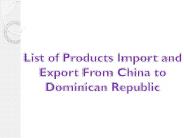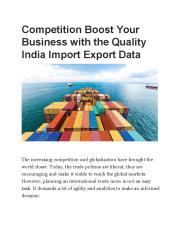CHAPTER XXIV LOCATING PRODUCTS TO EXPORT - PowerPoint PPT Presentation
Title:
CHAPTER XXIV LOCATING PRODUCTS TO EXPORT
Description:
Title: CHAPTER I INTRODUCTION Classical Theories of International Trade Author: m Last modified by: Chase Rhee Created Date: 11/14/2003 10:05:25 PM – PowerPoint PPT presentation
Number of Views:52
Avg rating:3.0/5.0
Title: CHAPTER XXIV LOCATING PRODUCTS TO EXPORT
1
CHAPTER XXIV LOCATING PRODUCTS TO EXPORT
LOCATING EXPORT MARKETS
- U. S. Exporters
- Purposes for Exporting
- Product Considerations
- Export Markets
2
U. S. Exporters
- Participants in U.S. Export per Export Trading
Company Guidebook of 1987 - 25 of U.S. exports by 50 companies
- 60 of U.S. exports by 200 companies
- 15 of U.S. exports by 24,250 companies
- Number of U.S. manufacturers 300,000 in 1980s
- 10 Exporters
- 90 Non-Exporters
3
U. S. Exporters
- A Profile of U.S. Importing Exporting Companies
by U.S. Census Bureau in 2015 - 294,800 exporting companies
- Large companies with 500 or more employees
- 2.4 of exporters but 67.1 of export value
- Small--Medium-sized companies with fewer than
500 employees - 97.6 of exporters but 32.9 of export value
4
U. S. Exporters
- High Export Concentration
- Top 250 exporters
- 52.2 of total export value
- Top 500 exporters
- 61.5 of total export value
5
U. S. Exporters
- Exporters classified by Industry
- Manufacturers 59.8 of total U.S. exporters
- Wholesalers 22.2
- Other exporters 18.0
- Trade with Related Parties
- 37.5 of total export value by multiple location
companies - 58.5 of exporters exported to only one foreign
country - Only 0.4 exported to 50 or more countries
6
Purposes for Exporting
- Four purposes for exporting
- Profit
- Growth
- Market Development
- Market Diversification
- Benefits obtainable from exporting of domestic
products - Lowers per unit fixed cost
- Increases product life cycles
- Compensates for seasonal or geographical
fluctuations - Defends domestic market from foreign competition
7
Product Considerations
- Specialize
- Know the products
- Start with local manufacturers
- Start with manufacturers who have not established
export channels - Start with manufacturers who are willing to
modify products to meet foreign customers' needs
8
Product Considerations
- As a non-manufacturing exporter, when locating
product for established foreign markets - Find out what products are needed in foreign
markets with which you are familiar. - Look for U.S. manufacturers who can supply
products which your foreign customers want to buy
- Yellow pages of telephone directories
- Manufacturers' Registers or Directories of each
State - Thomas Register of American Manufacturers
- Internet
9
Export Markets
- All foreign nations which want U.S. products and
have a means to pay for them (demand) - Number of Nations of the United Nations (UN)
- 51 members in 1945
- 189 2000
- 191 2002 (Switzerland Timor-Leste)
- 193 2011 (South Sudan)
10
Export Markets
- In locating export markets for domestic products
- Look for markets having similar characteristics
of your domestic buyers and users - Test exportability of your products by
advertising in Export USA (replaced Commercial
News USA in September 2013), USDC, International
Trade Administration. - Utilize international trade and economic
statistics - Participate in Catalog Video Exhibitions at the
U.S embassies or trade offices of U.S. Dept of
Commerce - Participate in Trade Shows and Trade Missions
11
Top 15 U.S. export markets for 2016 73.5 of
total U.S. exports
- 1. Canada
- 2. Mexico
- 3. China
- 4. Japan
- 5 United Kingdom
- 6. Germany
- 7. South Korea
- 8. Netherlands
- 9. Hong Kong
- 10. Belgium
- 11. France
- 12. Brazil
- 13. Singapore
- 14. Taiwan
- 15. Switzerland
12
Top 15 U.S. import sources for 2016 79.7 of
total U.S. imports
- 1. China
- 2. Mexico
- 3. Canada
- 4. Japan
- 5. Germany
- 6. South Korea
- 7. United Kingdom
- 8. France
- 9. India
- 10. Ireland
- 11. Italy
- 12. Vietnam
- 13. Taiwan
- 14. Malaysia
- 15. Switzerland































